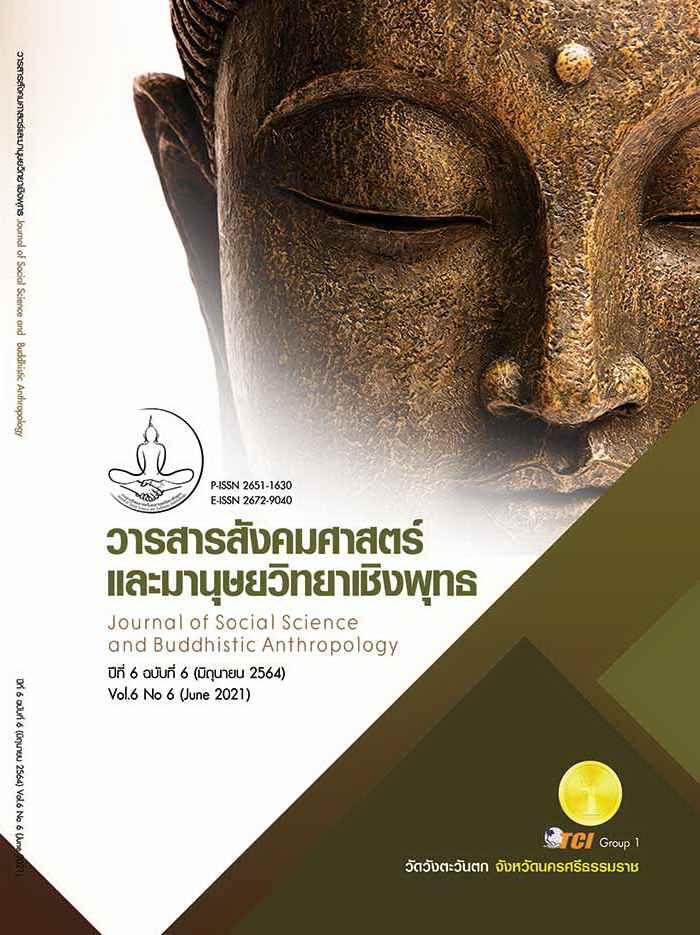รูปแบบการส่งเสริมจิตสาธารณะเชิงพุทธ ของบุคลากรมหาวิทยาลัยในกำกับของรัฐ
คำสำคัญ:
จิตสาธารณะ, รูปแบบการส่งเสริมจิตสาธารณะ, มหาวิทยาลัยในกำกับของรัฐบทคัดย่อ
บทความฉบับนี้มีวัตถุประสงค์เพื่อ 1) ศึกษาจิตสาธารณะเชิงพุทธของบุคลากร 2) พัฒนารูปแบบการส่งเสริมจิตสาธารณะเชิงพุทธของบุคลากร 3) เสนอรูปแบบการส่งเสริมจิตสาธารณะเชิงพุทธของบุคลากรมหาวิทยาลัยในกำกับของรัฐ โดยใช้ระเบียบวิธีวิจัยแบบผสมผสานวิธี ระหว่างการวิจัยเชิงปริมาณและการวิจัยเชิงคุณภาพ การวิจัยเชิงปริมาณ กลุ่มตัวอย่าง ได้แก่ บุคลากรมหาวิทยาลัยในกำกับของรัฐ จำนวน 384 คน โดยใช้ตารางสำเร็จรูปของเครจซี่และมอร์แกน เก็บข้อมูลโดยใช้แบบสอบถาม วิเคราะห์ข้อมูลโดยใช้สถิติ ค่าร้อยละ ค่าเฉลี่ย ส่วนเบี่ยงเบนมาตรฐาน การวิจัยเชิงคุณภพ เก็บข้อมูลโดยการสัมภาษณ์ผู้ทรงคุณวุฒิ จำนวน 10 คน สนทนากลุ่ม จำนวน 10 คน วิเคราะห์ข้อมูลโดยการวิเคราะห์เนื้อหา ผลการวิจัย พบว่า 1) จิตสาธารณะเชิงพุทธของบุคลากรมหาวิทยาลัยในกำกับของรัฐ มีความคิดเห็นโดยภาพรวมอยู่ในระดับมาก ทั้ง 3 ด้าน 2) พัฒนารูปแบบการส่งเสริมจิตสาธารณะเชิงพุทธของบุคลากรมหาวิทยาลัยในกำกับของรัฐ ประกอบด้วย 4 ส่วน ได้แก่ ส่วนที่ 1 ส่วนนำ คือ สภาพแวดล้อม หลักการ วัตถุประสงค์ ส่วนที่ 2 ตัวแบบ คือ ระบบงาน กระบวนการจัดการ ส่วนที่ 3 ขั้นตอนการนำไปใช้ คือ โครงสร้าง การตัดสินใจ แนวทางการประเมิน และส่วนที่ 4 เงื่อนไขความสำเร็จ 3) เสนอรูปแบบการส่งเสริมจิตสาธารณะเชิงพุทธฯ ได้แก่ ส่วนที่ 1 ส่วนนำ ได้แก่ สภาพแวดล้อม วัตถุประสงค์ ส่วนที่ 2 ตัวแบบ ประกอบด้วย ระบบงาน กระบวนการจัดการ ส่วนที่ 3 ขั้นตอนการนำไปใช้ ประกอบด้วย โครงสร้าง การตัดสินใจ การเสริมสร้างจิตสาธารณะในตนเอง แนวทางการประเมิน ส่วนที่ 4 เงื่อนไขความสำเร็จขึ้นอยู่กับบริบทของมหาวิทยาลัยในกำกับของรัฐ เช่น ความพร้อมของมหาวิทยาลัยในการจัดโครงการหรือกิจกรรมส่งเสริมจิตสาธารณะ นโยบาย วิสัยทัศน์ พันธกิจของมหาวิทยาลัยสามารถสรุปองค์ความรู้ได้ตาม “SSRRP Model” การส่งเสริมจิตสาธารณะเชิงพุทธ
เอกสารอ้างอิง
เจียมจิตต์ ไชยลังกา. (2554). การวิเคราะห์องค์ประกอบคุณลักษณะที่พึงประสงค์ด้านจิตสาธารณะของนักเรียนชั้นประถมศึกษาโรงเรียน ในสังกัดสานักงานเขต พื้นที่การศึกษาเชียงรายเขต 2. ใน วิทยานิพนธ์ครุศาสตรมหาบัณฑิต สาขาวิชาวิจัยและประเมินผลการศึกษา. มหาวิทยาลัยราชภัฏเชียงราย.
เทิดเกียรติ บรรจง. (2554). การศึกษากิจกรรมและจิตลักษณะที่ส่งผลต่อจิตสาธารณะของนักเรียนมัธยมศึกษาตอนต้น โรงเรียนมัธยมศึกษา จังหวัดนครศรีธรรมราช. ใน วิทยานิพนธ์ศิลปศาสตรมหาบัณฑิต สาขาวิชานโยบายและการวางแผนสังคม. มหาวิทยาลัยทักษิณ.
พรพรหม พรรคพวก. (2550). ปัจจัยบางประการที่ส่งผลต่อจิตสาธารณะของนักเรียนช่วงชั้นที่ 4 ในสหวิทยาเขตกรุงเทพตะวันออก กรุงเทพมหานคร. ใน วิทยานิพนธ์การศึกษามหาบัณฑิต สาขาการวิจัยและสถิติทางการศึกษา. มหาวิทยาลัยศรีนครนิทรวิโรฒ.
พระพรหมคุณาภรณ์ (ป.อ.ปยุตโต). (2550). ธรรมนูญชีวิต. (พิมพ์ครั้งที่ 80). กรุงเทพมหานคร: บริษัทพิมพ์สวยจำกัด.
พระราชบัญญัติระเบียบข้าราชการพลเรือนในสถาบันอุดมศึกษา (ฉบับที่ 2) 2551. (2551). ราชกิจจานุเบกษา เล่มที่ 125 ตอนที่ 28 ก หน้าที่ 37-38 (5 กุมภาพันธ์ 2551).
มณฑลี เนื้อทอง. (2556). การหล่อหลอมจิตอาสาผ่านการอบรมขัดเกลาทางสังคมในครอบครัว. นนทบุรี: มหาวิทยาลัยสุโขทัยธรรมาธิราช.
วิศัลย์ โฆษิตานนท์. (2550). การพัฒนาสำนึกสาธารณะของประชาชนในชุมชนเมือง จังหวัดเพชรบูรณ์. ใน ดุษฎีนิพนธ์ศิลปศาสตรดุษฎีบัณฑิต สาขาวิชาพัฒนาสังคม. มหาวิทยาลัยนเรศวร.
อมรรัตน์ เจริญชัย. (2550). การเสริมสร้างจิตสาธารณะ. วารสารการศึกษาทั่วไป, 7(30), 36-42.
อัญชลี ยิ่งรักพันธุ์. (2550). ผลการใช้สถานการณ์จำลองผสานกับเทคนิคการประเมินผลจากสภาพจริง เพื่อพัฒนาจิตสาธารณะของนักเรียน ชั้นประถมศึกษาปีที่ 5. ใน วิทยานิพนธ์การศึกษามหาบัณฑิต สาขาการวัดผลการศึกษา. มหาวิทยาลัยศรีนครินทรวิโรฒ.
อุทิศ การเพียร. (2558). การบริหารบุคลากรตามหลักพรหมวิหาร 4 ในทัศนะของบุคลากรตำแหน่งปฏิบัติการวิชาชีพและบริหารทั่วไป มหาวิทยาลัยมหาจุฬาลงกรณราชวิทยาลัย. ใน วิทยานิพนธ์พุทธศาสตรมหาบัณฑิต สาขาวิชาพระพุทธศาสนา. มหาวิทยาลัยมหาจุฬาลงกรณราชวิทยาลัย.
Best, J. W. (1970). Research in Education. (3 ed.). New jersey: Englewood Cliffs Pretice Hall.
Krejcie, R. V. & Morgan, D. W. (1970). Determining Sample Size for Research Activities. Educational and Psychological Measurement, 30(3), 607-610.
Likert, R. (1967). The Method of Constructing and Attitude Scale In Reading in Fishbeic, M (Ed.), Attitude Theory and Measurement. New York: Wiley & Son.








